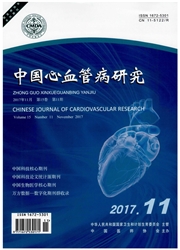

 中文摘要:
中文摘要:
目的 探讨糖基化终产物(AGEs)与其受体(RAGE)对ECV-304细胞上血管细胞黏附分子-1(ICAM-1)和细胞间黏附分子-1(VCAM-1)的影响,为研究AGEs在动脉粥样硬化发生发展中的作用提供实验依据.方法 采用体外制备的糖基化终产物——糖基化的牛血清白蛋白(AGE-BSA)和反义RAGE寡核苷酸处理ECV-304细胞,通过流式细胞仪技术、Western印迹技术检测ECV-304细胞上ICAM-1、VCAM-1蛋白质的表达.结果 AGEs处理ECV-304细胞后,可诱导ECV-304细胞上VCAM-1和ICAM-1的表达增加,且这种效应呈剂量依赖性.采用反义技术阻断RAGE的mRNA水平的翻译后,ECV-304细胞ICAM-1和VCAM-1的表达呈剂量依赖性降低.结论 AGEs可通过与其膜受体RAGE的结合激活血管内皮细胞VCAM-1和ICAM-1的表达,这可能是AGEs促动脉粥样硬化发生发展的机制之一.
 英文摘要:
英文摘要:
Objective To explore the role of advanced glycation end products (AGEs) and it's receptor (RAGEs) in modulating the expression of intercellular adhesion molecule-1 (ICAM-1 ) and vascular cell adhesion molecule-1 (VCAM-1) in human ECV-304 cell line. Methods Human ECs (ECV-304 cell line) were cultured in RPMI (Gibco -BRL) supplemented with 10% FCS (HyClone). AGEs was prepared by incubating 30% bovine serum albumin (BSA) with 16% glucose for 60 days at 37℃. Antisense technique was used to investigate the role of RAGE on the effect of AGEs in the endothelial cells. The expression of ICAM-1 and VCAM-1 was detected by flow cytometry and western blotting . Results Human ECs expressed ICAM-1 and VCAM-1. Treatment of ECs with the AGEs increased the expression of ICAM-1 and VCAM-1 protein in vitro in a concentration-dependent manner. But the effect was blocked by antisense RAGE oligonueleotides in a concentration- dependent manner. Conclusion AGEs may has proatherosclerotic potential by modulating the expression of ICAM-1 and VCAM-1 in ECV-304 cells, RAGE also participates the process. The study may provide a mechanism for pathogenesis of atherosclerosis induced by diabetes mellitus.
 同期刊论文项目
同期刊论文项目
 同项目期刊论文
同项目期刊论文
 期刊信息
期刊信息
